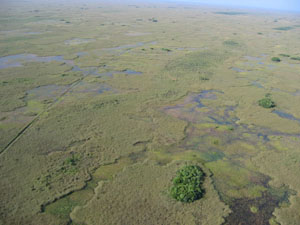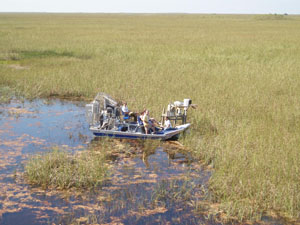
South Florida freshwater wetlands include forested and non-forested communities. Our discussion of these forested areas and our research within them is found on our Hammock and Tree islands section. The following is a description of these non-forested areas.
The most recognized community of the Everglades is the sawgrass marsh. Sawgrass (Cladium jamaicense) is adapted to survive year-round inundation and periodic burns. These sedges grow to 3 m on deeper peats, and remain closer to 1 m on shallower soils. Few other species are found in these dense marsh communities. Those present may include: spikerush (Eleocharis cellulosa), water hyssop (Bacopa caroliniana), marsh mermaid weed (Proserpinaca palustris), and Ipomoea sagitata.
 The Everglades are a vast mosaic of freshwater wetland communities. Sawgrass marsh is the most common type, but other communities are mixed in as well. Sloughs are found on the lowest elevation, and wettest sites. Floating aquatic plants dominate these areas, with white water lily (Nymphaea odorata), floating hearts (N. aquatica), and spatterdock (Nuphar advena) as the most common. These areas also include various submerged aquatics such as bladderworts (Utricularia spp.). Another community type is the wet prairie, defined as low stature gramminoid marshes that have distinct vegetation assemblages for both peat and marl substrates, generally called long and short hydroperiod marshes, respectively.
The Everglades are a vast mosaic of freshwater wetland communities. Sawgrass marsh is the most common type, but other communities are mixed in as well. Sloughs are found on the lowest elevation, and wettest sites. Floating aquatic plants dominate these areas, with white water lily (Nymphaea odorata), floating hearts (N. aquatica), and spatterdock (Nuphar advena) as the most common. These areas also include various submerged aquatics such as bladderworts (Utricularia spp.). Another community type is the wet prairie, defined as low stature gramminoid marshes that have distinct vegetation assemblages for both peat and marl substrates, generally called long and short hydroperiod marshes, respectively.
Long hydroperiod marshes are found in the wetter, interior Everglades sites. As a result of location and drainage patterns, the majority of the area within these wetlands remain inundated throughout both the wet and dry seasons, with variation in water levels. The peat-based wet prairies have low plant species diversity and generally include spikerush (Eleocharis cellulosa), beakrush (Rhynchospora tracyi), maidencane (Panicum hemitomon), arrowhead (Sagittaria lancifolia), and pickerel weed (Pontederia lanceolata). Floating periphyton mats are also important components of this community.